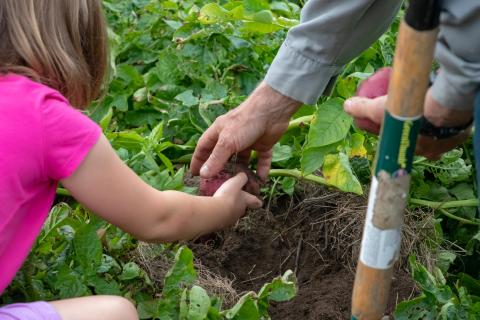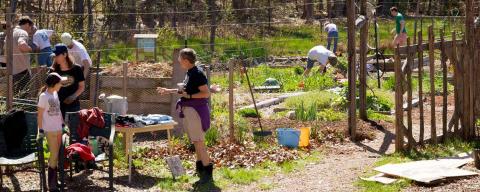Start Small, Grow Big
With proper planning and care, gardening success is possible even with limited money, time and experience. Whether your goal is to grow beautiful flowers or food for your family, there are so many ways to grow a garden to fit your goals, preferences and space. In this guide, you’ll learn about selecting and preparing your growing site, garden planning, seed starting and when to plant, garden care and maintenance, pest and disease management and, of course, harvesting and preservation.

Our fact sheet on preparing a vegetable site goes over:
- Considerations for choosing where to put your garden
- Ways of growing, namely raised beds or in-ground gardening
- Soil testing and amending
- Killing weeds and preparing the ground for planting
- Setting up irrigation
Before planting, it is never a bad idea to test the pH of the soil. In general, vegetable crops grow best in soils with a pH between 6.0 and 6.8. Most native soils in NH are much more acidic than this and require the addition of lime or wood ash to raise the pH and the addition of calcium and magnesium to the soil. If you intend to set up a raised bed garden, read this article on building and filling raised beds.
If growing in containers makes the most sense for you, we have a fact sheet on container growing as well.
Compost is generally recommended as a soil amendment when preparing a new garden site. Learn how to purchase high quality compost from our tip sheet.
If you would rather choose a site at a community garden, use this resource to find and connect with a community garden near you.
If you’re a fan of listening to podcasts, listen to part 1 and part 2 of our episode on planning your spring vegetable garden.
When setting up a garden, fencing and irrigation are worthwhile investments. Learn about efficient irrigation systems, like drip irrigation.
Lastly, investing in a compost pile, or bins, will ensure you have a steady supply of organic matter to add to your garden. Learn the basics of composting in our fact sheet.
Deciding when to start your seeds, and when to transplant your seedlings or direct seed into your garden, are important decisions. While there’s no way to predict when the last frost of the spring will be, by using historical last frost dates and understanding the cold tolerance and germination needs of different vegetables, you can make educated choices. Use our fact sheet on when to plant your vegetable garden as a starting point and guide for developing your own planting schedule.
For those vegetables and flowers that are best started indoors from seed, we have a fact sheet that goes over the basics. We also have a fact sheet that goes more in depth on indoor lighting.
If you’re a fan of podcasts, listen to our episode on how to start seeds successfully indoors.
Personal preference will determine whether you use synthetic fertilizers (such as 10-10-10), organic fertilizers from plant or animal-based materials or a mixture of the two. Regardless of which type of fertilizer you choose, it should be incorporated into the soil immediately before planting – not sooner. If fertilizer is applied too early, many of the nutrients may be lost before plants have a chance to use them. Check out our fact sheet on fertilizing vegetable gardens.
Go more in depth on fertilizing and amending the soil in your vegetable garden in our two-part podcast. Using manure and manure-based composts can be an excellent way of incorporating organic matter into your garden. Access our guidelines for how to do so safely and effectively.
You won’t want to go long before getting mulch down in your garden. Learn about your different mulch options in our garden mulches fact sheet.
For an introduction to identifying and managing problems in the garden, read our guide to managing pests while minimizing harmful effects to your health and the environment.
If you need some help identifying the cause of your plant problem, use our guide to getting best results from UNH Extension’s Infoline. You can call or email us and get consultation from New Hampshire Master Gardeners and Extension educators. We can help identify the problem and provide research-based recommendations to manage it.
Sometimes we will need a physical plant sample to correctly identify the cause of a problem. For those situations, we offer a plant disease and diagnosis service. Learn about how to use that diagnostic service here.
Most insects you might encounter in and around your gardens are not pests, and some are quite beneficial. Learn about some of our beneficial insects in this fact sheet.
Many problems can be prevented by following some basic best practices. Get some ideas in this short guide.
Using pesticides should be a measure of last resort. For diseases, prevention is key, and even bactericides and fungicides are typically only useful for suppressing further infection. For insects, excluding insects from accessing your plants is often an effective strategy. Learn about using row covers in this guide.
When you do choose to use a pesticide, which includes insecticides, fungicides and herbicides, we have a resource that goes over how to read and understand product labels and how to choose an appropriate product for your needs. Dig into that here. We also have a list of considerations for buying a pesticide.
You might be inclined to use a natural, organic product. This article addresses whether those products are safer for your garden and how to use them. This article specifically addresses using neem oil.
We have resources on a wide variety of insect pests and diseases, but below are some of the most common issues we identify:
While there are many best practices and principles that apply to growing vegetables in the garden, there are also some aspects of growing individual crops that are unique. Utilize our growing guides to get best results for growing specific vegetables in your garden.
Many vegetables require frequent harvesting, as often as every morning or every other morning. Tomatoes, summer squash, beans, peas and cucumbers are all crops that require frequent harvesting. If you don’t harvest enough to keep up with production, the plants will actually produce less. There’s also a risk with leaving ripe produce in the garden that animals will get into them, which can make produce unsafe to eat.
Look for signs that animals have been in the garden (such as footprints and droppings, which can pose a health risk by harboring parasites and disease organisms). Dispose of fruits and vegetables that may have come in contact with animals and their feces.
The easier the garden is to see and access, the more likely it will be visited on a regular basis.
The mark of having a truly successful production garden is having enough produce to preserve for use over the winter months. Many vegetables lend themselves well to both canning and freezing. Both of these methods are excellent ways of preserving surplus food, as long as they are done properly!
Do you love learning about stuff like this?
SUBSCRIBE TO Granite State Gardening newsletter
Got questions? The UNH Extension Yard and Garden Infoline offers practical help finding answers for your yard and garden questions.
Call toll free at 1-877-398-4769, Monday to Friday, 9 a.m. to 2 p.m., or fill out webform.

